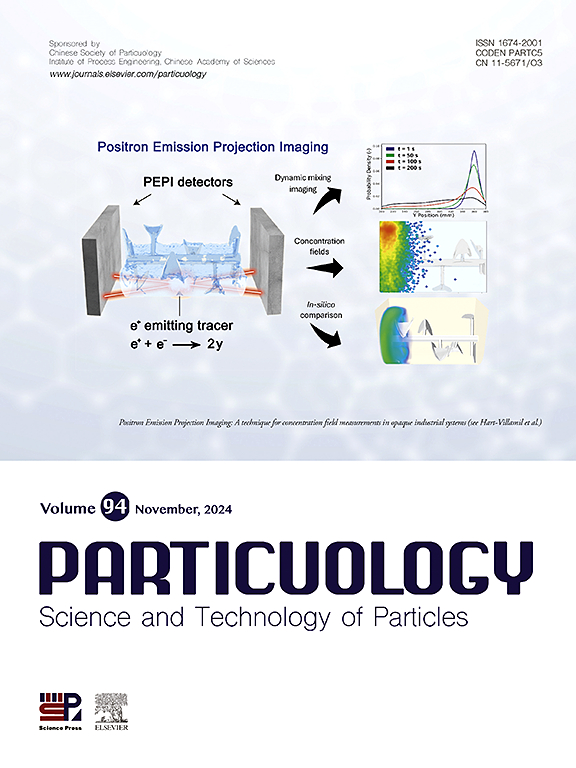通过改进的分级旋流器缩小粉末涂料的粒度分布:改善流动性和薄膜质量
IF 4.3
2区 材料科学
Q2 ENGINEERING, CHEMICAL
引用次数: 0
摘要
本文提出了一种新型的二次进风导风旋风分级分离器(SAG型),以缩小粒径分布(PSD)。CFD模拟表明,仅在气旋底部增加二次进气口(SA型)就会产生强烈的上升气流。加入导风器后,旋转的空气增强了外涡的强度,有利于颗粒的收集。实验结果也验证了这些发现。SA旋风分离器有效地缩小了PSD,但大大降低了颗粒收集效率。相比之下,SAG旋风分离器可以在保持高颗粒收集效率的同时降低PSD。此外,还发现颗粒的收集效率随着二次风入口开度的增大而降低,但SAG旋风分离器对此不太敏感,在实际应用中更易控制。为了进一步评估旋风改性对涂料粉末和薄膜性能的影响,分别采用原旋风和SAG旋风制备了宽PSD和窄PSD的粉末涂料。研究发现,通过改造旋流器来减小粉体的展长,可以有效提高颗粒的流动性(休止角(AOR)、雪崩角(AVA)和旋转床膨胀率(RBER))和成膜性能(图像清晰度(DOI)和表面平整度)。该研究为缩小粉末涂料的PSD,改善粉末涂料的流动性和成膜性能提供了指导。本文章由计算机程序翻译,如有差异,请以英文原文为准。

Narrowing the particle size distribution of powder coatings via a reformed classifying cyclone: Improved flowability and film qualities
In this study, a new design of classifying cyclone separator with secondary air inlet and air guider (SAG type) was proposed to narrow the particle size distribution (PSD). CFD simulation reveals that only adding a secondary air inlet (SA type) at the bottom of the cyclone will create a strong updraft. After adding an air guider, the rotating air enhances the strength of the outer vortex, which is conducive to the particle collection. The experiment results also verify these findings. SA cyclone separator effectively narrows the PSD, but the particle collection efficiency is greatly reduced. In contrast, SAG cyclone separator can decrease the PSD while maintaining a high particle collection efficiency. In addition, it is also found that the collection efficiency of particles decreases with the increase of the opening size of the secondary air inlet, but the SAG cyclone separator is less sensitive to this, making it more controllable in practical applications. To further assess the impact of cyclone modification on coating powder and film properties, the powder coatings with wide PSD and narrow PSD were prepared by original cyclone and SAG cyclone, respectively. It was found that reducing the span of the powder by modifying the cyclone can effectively improve the flowability (angle of repose (AOR), avalanche angle (AVA) and rotating bed expansion rate (RBER)) and film properties (distinctness of image (DOI) and surface flatness) of the particles. This study provides guidance for narrowing the PSD and improving the flowability and film properties of powder coatings.
求助全文
通过发布文献求助,成功后即可免费获取论文全文。
去求助
来源期刊

Particuology
工程技术-材料科学:综合
CiteScore
6.70
自引率
2.90%
发文量
1730
审稿时长
32 days
期刊介绍:
The word ‘particuology’ was coined to parallel the discipline for the science and technology of particles.
Particuology is an interdisciplinary journal that publishes frontier research articles and critical reviews on the discovery, formulation and engineering of particulate materials, processes and systems. It especially welcomes contributions utilising advanced theoretical, modelling and measurement methods to enable the discovery and creation of new particulate materials, and the manufacturing of functional particulate-based products, such as sensors.
Papers are handled by Thematic Editors who oversee contributions from specific subject fields. These fields are classified into: Particle Synthesis and Modification; Particle Characterization and Measurement; Granular Systems and Bulk Solids Technology; Fluidization and Particle-Fluid Systems; Aerosols; and Applications of Particle Technology.
Key topics concerning the creation and processing of particulates include:
-Modelling and simulation of particle formation, collective behaviour of particles and systems for particle production over a broad spectrum of length scales
-Mining of experimental data for particle synthesis and surface properties to facilitate the creation of new materials and processes
-Particle design and preparation including controlled response and sensing functionalities in formation, delivery systems and biological systems, etc.
-Experimental and computational methods for visualization and analysis of particulate system.
These topics are broadly relevant to the production of materials, pharmaceuticals and food, and to the conversion of energy resources to fuels and protection of the environment.
 求助内容:
求助内容: 应助结果提醒方式:
应助结果提醒方式:


